 The words figure and fictitious both derive from the same Latin root, fingere (to form, create). Beware!
--M.J. Moroney
The words figure and fictitious both derive from the same Latin root, fingere (to form, create). Beware!
--M.J. Moroney The words figure and fictitious both derive from the same Latin root, fingere (to form, create). Beware!
--M.J. Moroney
The words figure and fictitious both derive from the same Latin root, fingere (to form, create). Beware!
--M.J. Moroney
Everything is vague to a degree you do not realize :till you have tried to make it precise. --Bertrand Russell
I'm pretty certain that I need better ways to handle uncertainty. Many expressions of human knowledge are not crisp ideas. Rather, they are hedges, shades of gray.
Consider four problems in programming a game:
The problem is that conventional principles of logic are very unfriendly towards uncertainty. In classical logic, things are either true or false. You do, you don't. Worse, if a model contains a single inconsistency, the whole theory is false. So one little doubt, one little "this or not this" and you are screwed. Not very helpful for introducing gradual degrees of hedged knowledge that may be contradictory.
.jpg/200px-Lotfi_A._Zadeh(2004).jpg) This is not just a game playing problem.
The drawbacks of classical logic are well known.
Theoreticians like Lofti Zadeh offer a Principle of Incompatibility :
This is not just a game playing problem.
The drawbacks of classical logic are well known.
Theoreticians like Lofti Zadeh offer a Principle of Incompatibility :
 Philosophers like Karl Popper claim that accessing 100% evidence on any topic a fool's goal. All "proofs" must terminate on premises; i.e. some proposition that we accept as
true without testing, but which may indeed be wrong.
In terms of most human knowledge, a recursion to base premises is
fundamentally impractical. For example:
Philosophers like Karl Popper claim that accessing 100% evidence on any topic a fool's goal. All "proofs" must terminate on premises; i.e. some proposition that we accept as
true without testing, but which may indeed be wrong.
In terms of most human knowledge, a recursion to base premises is
fundamentally impractical. For example:
There is much evidence for Popper's thesis. Gathering all the information required to remove all uncertainties can be very difficult:
 The (in)famous "Limits to Growth"
study attempted to predict the international effects of continued global economic growth. Less than 0.1% of the data required for the models was available
The (in)famous "Limits to Growth"
study attempted to predict the international effects of continued global economic growth. Less than 0.1% of the data required for the models was available
Experience with mathematical simulation suggest that an over-enthusiasm for quantitative analysis can confuse, rather than clarify, a domain. For systems whose parts are not listed in a catalog, which evolve together, which are difficult to measure, and which show unexpected capacity to form new connections, the results of (quantitative) simulation techniques have been less than impressive:
Anyway, why seek total knowledge? Some levels of uncertainty are a good thing:
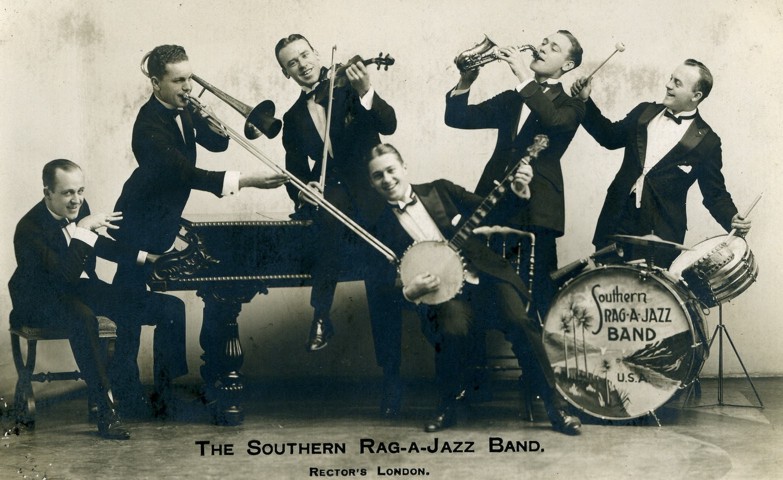 When co-ordinating multiple agents, it is good to leave some room for
local improvisation. Consider the phrase "close enough for jazz":
When co-ordinating multiple agents, it is good to leave some room for
local improvisation. Consider the phrase "close enough for jazz":
Sometimes we can learn more by allowing some uncertainties. Creative solutions and insights can sometimes be found in a loosely constrained space than may be impossible in tightly constrained, certain spaces. For example,
PROXIMITY
SIZE close medium far
-------- ----------------------
tiny medium low low
small high low low
moderate high medium low
large high high medium
So we need to change classical logic. Uncertainty is unavoidable. Despite this, we persist and continue building systems of increasing size and internal complexity. Somehow, despite uncertainty, we can handle uncertainty and doubt and predict the future a useful percent of the time. How do we do it? How can we teach AI algorithms to do it?
 Officially, there are rules. Unofficially, there are shades of gray. Fuzzy logic is one way to
handle such shades of gray.
Officially, there are rules. Unofficially, there are shades of gray. Fuzzy logic is one way to
handle such shades of gray.
For example, consider the rule ``if not raining then play golf''. Strange to say, sometimes people play golf even in the rain. Sure, they may not play in a hurricane but a few drops of rain rarely stops the dedicated golfer.
Fuzzy logic tries to capture these shades of gray. Our golf rule means that we rush to play golf in the sunshine, stay home during hurricanes, and in between we may or may not play golf depending on how hard it is raining.
Fuzzy logic uses fuzzy sets. Crisp sets have sharp distinctions between true and falsehood (e.g. it is either raining or not). Fuzzy sets have blurred boundaries (e.g. it is barely raining). Typically, a membership function is used to denote our belief in some concept. For example, here are some membership functions for the belief that a number is positive. All these beliefs have the same membership function:
1/(1+exp(-1*x*crisp))
Or, in another form...
(defun crisp (x a b crisp)
"Return a point in a sigmoid function centered at (a - b)/2"
(labels ((as100 (x min max)
(+ -50 (* 100 (/ (- x min) (- max min))))))
(/ 1 (+ 1 (exp (* -1 (as100 x a b) crisp))))))
(defun fuzzy-grade (x &optional (a 0) (b 1) (slope 0.1))
(crisp x a b slope))
where the crisp parameter controls how sharp is the boundary in our beliefs:
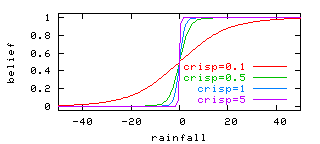
Note that for large crisp values the boundary looks like classical logic: at zero a number
zaps from positive to negative.
However, in the case of our golfing rule, there are
shades of gray in between sunshine and hurricanes.
We might believe in playing golf, even when
there is a little rain around.
For these situations, our beliefs are hardly crisp, as modeled by setting
crisp to some value less than (say) one.
The crisp value lets us operationalize a set of linguistic variables or hedges such as ``barely'', ``very'', ``more or less'', ``somewhat,'' ``rather,'' ``sort of,'' and so on. In this approach, analysts debrief their local experts on the relative strengths of these hedges then add hedge qualifiers to every rule. Internally, this just means mapping hedges to crisp values. For example:
definitely: crisp=10 sort of: crisp=0.5 etc
Alternatively, analysts can ask the local experts to draw membership functions showing how the degrees of belief in some concept changes over its range. For example:
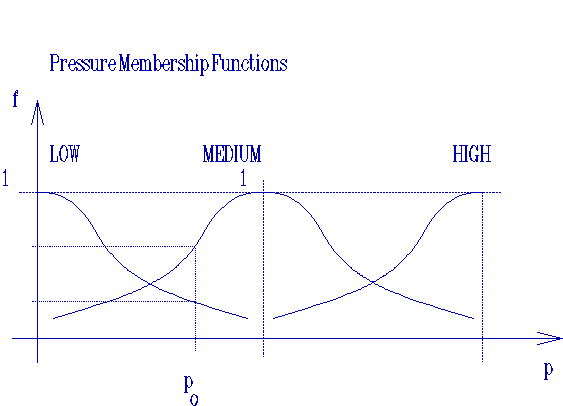
Sometimes, these can be mapped to mathematical functions as in the following:
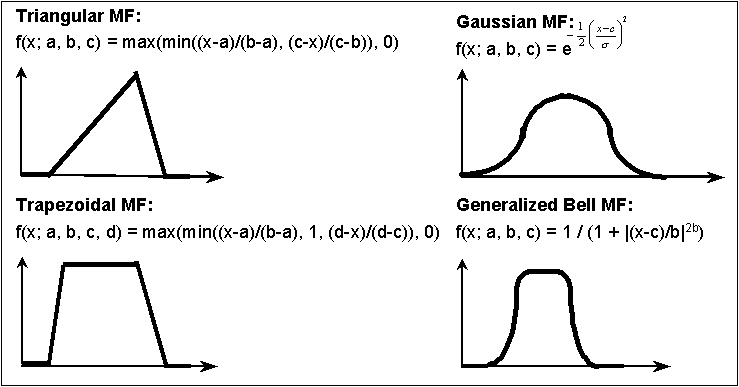
(defun fuzzy-triangle (x a b c) (max 0 (min (/ (- x a) (- b a)) (/ (- c x) (- c b))))) (defun fuzzy-trapezoid (x a b c d) (max 0 (min (/ (- x a) (- b a)) 1 (/ (- d x) (- d c)))))
Note that the function need not be represented mathematically. If the local experts draw any shape at all, we could read off values from that drawing and store them in an array. For example, an analyst can construct an array of values for various terms, either as vectors or matrices. Each term and hedge can be represented as (say) a 7-element vector or 7x7 matrix. Each element of every vector and matrix a value between 0.0 and 1.0, inclusive, in what might be considered intuitively a consistent manner. For example, the term ``high'' could be assigned the vector
0.0 0.0 0.1 0.3 0.7 1.0 1.0
and ``low'' could be set equal to the reverse of ``high,'' or
1.0 1.0 0.7 0.3 0.1 0.0 0.0
The AND, OR, NOT operators of boolean logic exist in fuzzy logic, usually defined as the minimum, maximum, and complement; i.e.
[1] truth (not A) = 1.0 - truth (A)
[2] truth (A and B) = minimum (truth(A), truth(B))
[3] truth (A or B) = maximum (truth(A), truth(B))
Or, in another form...
(defmacro $and (&rest l) `(min ,@l)) (defmacro $or (&rest l) `(max ,@l)) (defun $not (x) (- 1 x))
When they are defined this way, the are called the Zadeh operators, because they were originally defined as such in Zadeh's original papers.
Here are some examples of the Zadeh operators in action:
[1] truth (not A) = 1.0 - truth (A)


[2] truth (A and B) = minimum (truth(A), truth(B))



[3] truth (A or B) = maximum (truth(A), truth(B))



Here are some more examples:

Here's yet another example

Some researchers in fuzzy logic have explored the use of other interpretations of the AND and OR operations, but the definition for the NOT operation seems to be safe.
Note that if you plug just the values zero and one into the definitions [1],[2],[3], you get the same truth tables as you would expect from conventional Boolean logic. This is known as the EXTENSION PRINCIPLE, which states that:
Assume that we have some fuzzy sub membership functions for combination of TALL and OLD things defined as follows:
function tall(height) {
if (height < 5 ) return Zero;
if (height <=7 ) return (height-5)/2;
return 1;
}
function old(age) {
if (age < 18) return Zero;
if (age <= 60) return (age-18)/42;
return 1;
}
function a(age,height) { return FAND(tall(height),old(age)) }
function b(age,height) { return FOR(tall(height), old(age)) }
function c(height) { return FNOT(tall(height)) }
function abc(age,height) {
return FOR(a(age,height),b(age,height),c(height)) }
(The functions FNOR, FAND, FOR are the Zadeh operators.)
For compactness, we'll call our combination functions:
a = X is TALL and X is OLD
b = X is TALL or X is OLD
c = not (X is TALL)
abc= a or b or c
Here's the OLDness functions:
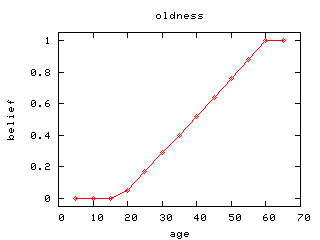
Here's the TALLness function:
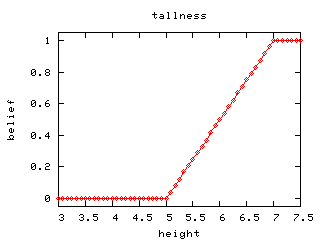
Here's (c); i.e. the not TALLness function:
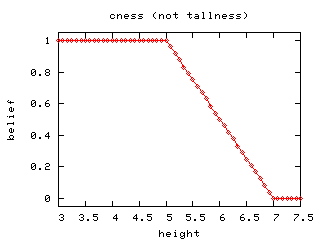
Here's (a): TALL and OLD
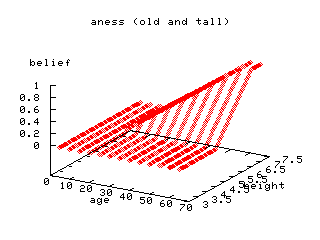
Here's (b): TALL or OLD
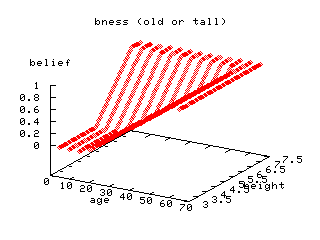
Here's (abc): a or b or c
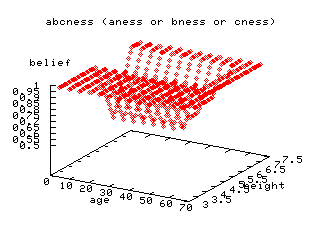
Methodology, a fuzzy logic session looks like this:
Suppose we have an output fuzzy set AMOUNT which has three members: ZERO, MEDIUM, and HIGH. We assign to each of these fuzzy set members a corresponding output value, say 0 for Zero, 40 for MEDIUM, and 100 for HIGH. A Defuzzification procedure might then be:
return (ZERO*0 + MEDIUM*40 + HIGH*100)/(0+40+100)
How close is the enemy?
How large is the enemy's forces?
What is the size of the threat?
PROXIMITY
SIZE close medium far
-------- ----------------------
tiny medium low low
small high low low
moderate high medium low
large high high medium
We need some membership functions:
(defun dist (d what)
(case what
(range '(close medium far))
(close (fuzzy-triangle d -30 0 30))
(medium (fuzzy-trapezoid d 10 30 50 70))
(far (fuzzy-grade d 0.3 50 100))
(t (warn "~a not known to dist" what))))
(defun size (s what)
(case what
(range '(tiny small moderate large))
(tiny (fuzzy-triangle s -10 0 10))
(small (fuzzy-trapezoid s 2.5 10 15 20))
(moderate (fuzzy-trapezoid s 15 20 25 30))
(large (fuzzy-grade s 0.3 25 40))
(t (warn "~a not known to size " what))))
And we'll need to model the above table:
(defun fuzzy-deploy (d s what)
(macrolet (($if (x y) `($and (dist d ',x) (size s ',y))))
(case what
(range '(low medum high))
(low ($or ($if medium tiny)
($if far tiny)
($if medium small)
($if far small)))
(medium ($or ($if close tiny)
($if medium moderate)))
(high ($or ($if close small)
($if close moderate)
($if close large)
($if medium moderate)))
(t (warn "~a not known to fuzzy-deploy" what)))))
Finally, we need a defuzzication function:
(defun defuzzy-deploy (&key distance size)
"Return how many marines to deploy?"
(let ((low (fuzzy-deploy distance size 'low ))
(medium (fuzzy-deploy distance size 'medium))
(high (fuzzy-deploy distance size 'high )))
(round
(/ (+ (* 10 low) (* 30 medium) (* 50 high))
(+ low medium high)))))
So, how many marines to deploy?
(defuzzy-deploy :distance 25 :size 8)) ==> 19
